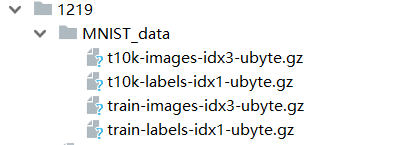https://morvanzhou.github.io/tutorials/machine-learning/tensorflow/5-08-RNN2/
1.设置 RNN 的参数
RNN 从每张图片的第一行像素读到最后一行, 然后再进行分类判断.
(1)导入 MNIST 数据并确定 RNN 的各种参数
下载地址: http://yann.lecun.com/exdb/mnist/

import tensorflow as tf
from tensorflow.examples.tutorials.mnist import input_data
tf.set_random_seed(1) # set random seed
# 导入数据
mnist = input_data.read_data_sets('MNIST_data', one_hot=True)
# hyperparameters
lr = 0.001 # learning rate
training_iters = 100000 # train step 上限
batch_size = 128
n_inputs = 28 # MNIST data input (img shape: 28*28)
n_steps = 28 # time steps
n_hidden_units = 128 # neurons in hidden layer
n_classes = 10 # MNIST classes (0-9 digits)
(2)定义 x, y 的 placeholder 和 weights, biases 的初始状况
x = tf.placeholder(tf.float32, [None, n_steps, n_inputs])
y = tf.placeholder(tf.float32, [None, n_classes])
weights = {
# shape (28, 128)
'in': tf.Variable(tf.random_normal([n_inputs, n_hidden_units])),
# shape (128, 10)
'out': tf.Variable(tf.random_normal([n_hidden_units, n_classes]))
}
biases = {
# shape (128, )
'in': tf.Variable(tf.constant(0.1, shape=[n_hidden_units, ])),
# shape (10, )
'out': tf.Variable(tf.constant(0.1, shape=[n_classes, ]))
}
2.定义 RNN 的主体结构
RNN 总共有 3 个组成部分 ( input_layer, cell, output_layer)
# (1)input_layer
def RNN(X, weights, biases):
# 原始的 X 是 3 维数据, 我们需要把它变成 2 维数据才能使用 weights 的矩阵乘法
# X ==> (128 batches * 28 steps, 28 inputs)
X = tf.reshape(X, [-1, n_inputs])
# X_in = W*X + b
X_in = tf.matmul(X, weights['in']) + biases['in']
# X_in ==> (128 batches, 28 steps, 128 hidden) 换回3维
X_in = tf.reshape(X_in, [-1, n_steps, n_hidden_units])
# (2)cell
# 使用 basic LSTM Cell.
lstm_cell = tf.nn.rnn_cell.BasicLSTMCell(n_hidden_units, forget_bias=1.0, state_is_tuple=True)
init_state = lstm_cell.zero_state(batch_size, dtype=tf.float32) # 初始化全零 state
# (3)output_layer
outputs, states = tf.nn.dynamic_rnn(lstm_cell, X_in, initial_state=init_state, time_major=False)
results = tf.matmul(states[1], weights['out']) + biases['out']
return results
3.计算 cost 和 train_op
pred = RNN(x, weights, biases)
cost = tf.reduce_mean(tf.nn.softmax_cross_entropy_with_logits(logits=pred, labels=y))
train_op = tf.train.AdamOptimizer(lr).minimize(cost)
4.训练 RNN
correct_pred = tf.equal(tf.argmax(pred, 1), tf.argmax(y, 1))
accuracy = tf.reduce_mean(tf.cast(correct_pred, tf.float32))
init = tf.initialize_all_variables()
with tf.Session() as sess:
sess.run(init)
step = 0
while step * batch_size < training_iters:
batch_xs, batch_ys = mnist.train.next_batch(batch_size)
batch_xs = batch_xs.reshape([batch_size, n_steps, n_inputs])
sess.run([train_op], feed_dict={
x: batch_xs,
y: batch_ys,
})
if step % 20 == 0:
print(sess.run(accuracy, feed_dict={
x: batch_xs,
y: batch_ys,
}))
step += 1
5.结果展示
0.265625
0.7265625
0.828125
0.8828125
0.84375
0.859375
0.8984375
0.890625
0.84375
0.90625
0.921875
0.90625
0.9140625
0.9140625
0.9375
0.9609375
0.953125
0.921875
0.9453125
0.96875
0.9375
0.9609375
0.890625
0.984375
0.953125
0.953125
0.9453125
0.9453125
0.96875
0.9375
0.953125
0.96875
0.9375
0.9921875
0.9609375
0.9609375
0.953125
0.9609375
0.96875
0.96875
Process finished with exit code 0